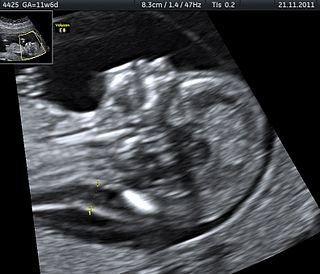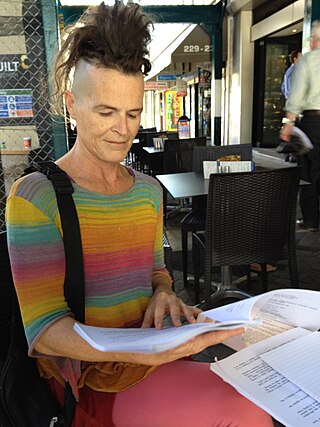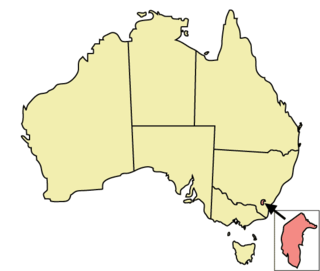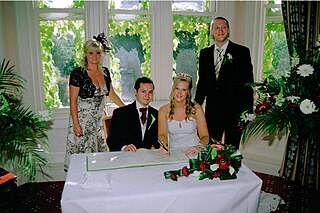
Name change is the legal act by a person of adopting a new name different from their current name.
A birth certificate is a vital record that documents the birth of a person. The term "birth certificate" can refer to either the original document certifying the circumstances of the birth or to a certified copy of or representation of the ensuing registration of that birth. Depending on the jurisdiction, a record of birth might or might not contain verification of the event by a healthcare professional such as a midwife or doctor.

Stillbirth is typically defined as fetal death at or after 20 or 28 weeks of pregnancy, depending on the source. It results in a baby born without signs of life. A stillbirth can often result in the feeling of guilt or grief in the mother. The term is in contrast to miscarriage, which is an early pregnancy loss, and Sudden Infant Death Syndrome, where the baby dies a short time after being born alive.

The General Register Office for England and Wales (GRO) is the section of the United Kingdom HM Passport Office responsible for the civil registration of births, adoptions, marriages, civil partnerships and deaths in England and Wales and for those same events outside the UK if they involve a UK citizen and qualify to be registered in various miscellaneous registers. With a small number of historic exceptions involving military personnel, it does not deal with records of such events occurring within the land or territorial waters of Scotland, Northern Ireland or the Republic of Ireland; those entities' registration systems have always been separate from England and Wales.
Civil registration is the system by which a government records the vital events of its citizens and residents. The resulting repository or database has different names in different countries and even in different subnational jurisdictions. It can be called a civil registry, civil register, vital records, and other terms, and the office responsible for receiving the registrations can be called a bureau of vital statistics, registry of vital records and statistics, registrar, registry, register, registry office, or population registry. The primary purpose of civil registration is to create a legal document that can be used to establish and protect the rights of individuals. A secondary purpose is to create a data source for the compilation of vital statistics.

General Register Office or General Registry Office (GRO) is the name given to the civil registry in the United Kingdom, many other Commonwealth nations and Ireland. The GRO is the government agency responsible for the recording of vital records such as births, deaths, and marriages, which may also include adoptions, stillbirths, civil unions, etc., and historically, sometimes included records relating to deeds and other property transactions.

Lesbian, gay, bisexual and transgender (LGBT) rights in Australia significantly advanced over the latter half of the twentieth century and early twenty-first century, and are now ranked among the highest in the world. Opinion polls and the Australian Marriage Law Postal Survey indicate widespread popular support for same-sex marriage within the nation. A 2013 Pew Research poll found that 79% of Australians agreed that homosexuality should be accepted by society, making it the fifth-most supportive country surveyed in the world. With its long history of LGBT activism and annual Gay and Lesbian Mardi Gras festival, Sydney has been named one of the most gay-friendly cities in the world.
A register office or The General Register Office, much more commonly but erroneously registry office, is a British government office where births, deaths, marriages, civil partnership, stillbirths and adoptions in England, Wales and Northern Ireland are registered. It is the licensed local of civil registry.
A marriage certificate is an official statement that two people are married. In most jurisdictions, a marriage certificate is issued by a government official only after the civil registration of the marriage.
Tasmania's Relationships Act 2003 provided for registration and recognition of a type of registered partnership in two distinct categories: Significant Relationships and Caring Relationships. The same Act also amended 73 pieces of legislation to provide registered partners with nearly all of the rights offered to married couples within the state. Furthermore, since July 2009, these relationships are recognised at federal level, providing couples with almost all of the federal rights and benefits of marriage. The legislation came into effect on 1 January 2004. In September 2010, the Parliament of Tasmania approved legislation to recognize same-sex unions performed outside Tasmania as significant relationships.

Lesbian, gay, bisexual, and transgender (LGBT) persons in the Australian state of New South Wales have most of the same rights and responsibilities as heterosexual cisgender people.

Norrie, also known by the pseudonym Norrie May-Welby, is a Scottish-Australian transgender person who pursued the legal status of being neither a man nor a woman, between 2010 and 2014. The High Court of Australia ruled in April 2014 that it was in the power of the NSW Registry of Births, Deaths and Marriages to record in the register that the sex of Norrie was 'non-specific'.

Marriage in Australia is regulated by the federal government, which is granted the power to make laws regarding marriage by section 51(xxi) of the constitution. The Marriage Act 1961 applies uniformly throughout Australia to the exclusion of all state laws on the subject.

The Australian Capital Territory (ACT) is one of Australia's leading jurisdictions with respect to the rights of lesbian, gay, bisexual, transgender, queer and intersex (LGBTQI) people. The ACT has made a number of reforms to territory law designed to prevent discrimination of LGBT people; it was the only state or territory jurisdiction in Australia to pass a law for same-sex marriage, which was later overturned by the High Court of Australia. The Australian Capital Territory, Victoria and Queensland are the only jurisdictions within Australia to legally ban conversion therapy on children. The ACT's laws also apply to the smaller Jervis Bay Territory.

A civil, or registrar, ceremony is a non-religious legal marriage ceremony performed by a government official or functionary. In the United Kingdom, this person is typically called a registrar. In the United States, civil ceremonies may be performed by town, city, or county clerks, judges or justices of the peace, or others possessing the legal authority to support the marriage as the wedding officiant.
Transgender rights in Australia have legal protection under federal and state/territory laws, but the requirements for gender recognition vary depending on the jurisdiction. For example, birth certificates, recognised details certificates, and driver licences are regulated by the states and territories, while Medicare and passports are matters for the Commonwealth.
Australia does not have a national identity card. Instead, various Identity documents of Australia may be used or required to prove a person's identity, whether for government or commercial purposes such as:
Digital identity is used in Australia by residents to validate who they are over digital media, such as over the Internet.

The Civil Partnerships, Marriages and Deaths Act 2019 is an Act of Parliament of the United Kingdom which changes civil partnerships to include heterosexual couples, the way in which stillbirths are recorded and how a Coroner's inquest into stillbirths are conducted.
In Australia, a recognised details certificate is a vital record issued by a state or territory's Registry of Births, Marriages, and Deaths, certifying that a person not born in that state or territory has recorded a change of gender with the Registry.












